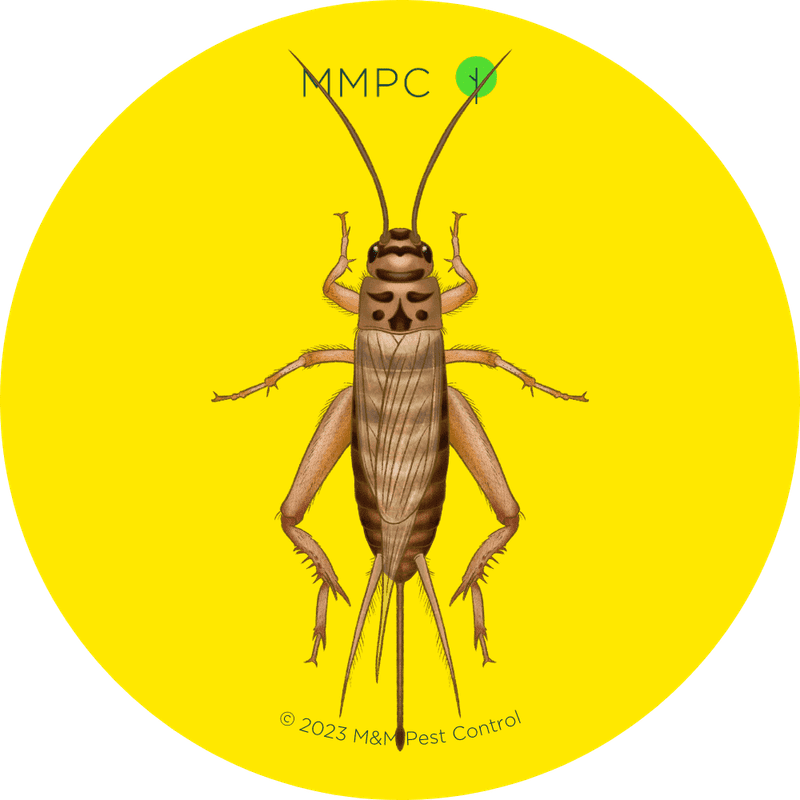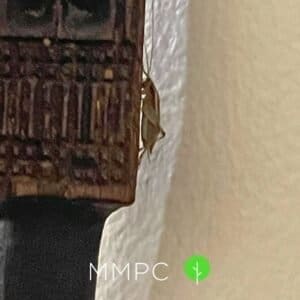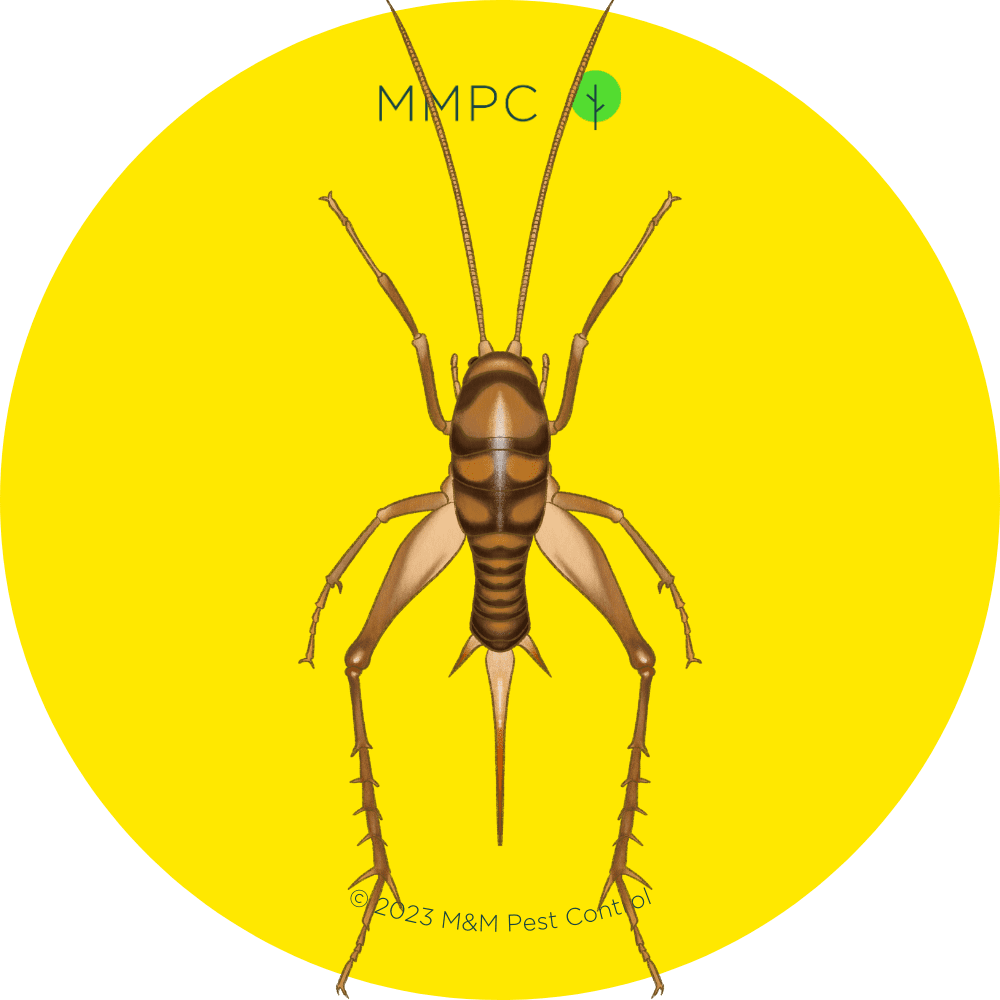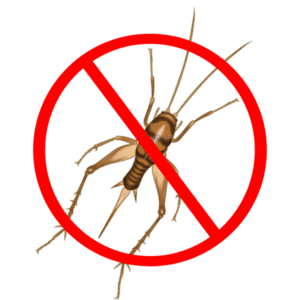Cricket Identification & Control

What Are Crickets?
Crickets, from the order Orthoptera, are jumping insects known for their distinctive chirping sounds. While they do not pose any direct threat to humans or spread diseases, their loud chirping can be a significant nuisance, especially at night. In addition to being noisy, crickets can also damage fabrics, paper, and other materials in your home.
Crickets are attracted to warm, moist environments and are often drawn to outdoor lights at night. Controlling crickets involves reducing moisture indoors, sealing entry points, and addressing outdoor lighting issues. Pesticides can also be used as a supplement to these methods.
Appearance
Crickets have cylindrical bodies with long, thread-like antennae and strong hind legs designed for jumping. Most crickets have two pairs of large wings, though not all species do.
Behavior
Crickets are most active at night, which is when you typically hear them chirping. They normally live outdoors but may enter homes to seek shelter—especially during late summer and fall. Indoors, they prefer to hide in dark areas with plenty of warmth and moisture.
Males produce chirping sounds by rubbing their front wings together (an act called stridulation) to attract females.
Risks
While crickets don’t harm humans directly, they can cause property damage. They feed on fabrics like wool, cotton, silk, and synthetic materials, leaving roughened areas. Severe infestations can result in larger areas of damage, particularly to fabrics and paper.
Identification

House Cricket
House crickets (Acheta domesticus) are pale yellowish-brown or straw-colored, with dark brown stripes on their heads. They are known for their loud chirping, especially at night, and are attracted to lights and warm areas.
Indoors, house crickets tend to congregate in warm areas such as kitchens, near heaters, closets, or in upholstered furniture. They like to feed on fabrics, leaving behind holes and stains (from droppings) on clothes and furniture.


Size: 5/8″ – 7/8″ (16 – 21 mm)
Color: Pale yellowish-brown with dark markings
Identifying Features:
- 3 dark crossbands on the top of the head
- 2 long, outward-pointing appendages (cerci) extending from the rear
- 2 pairs of long, pointed wings (males chirp by rubbing the edges of the forewings together)
- Females have a long, sword-like appendage (ovipositor) extending from the rear
- 6 legs (the hind pair is extra long with enlarged femora)
- Long, thread-like antennae

Camel Cricket
Camel crickets (Rhaphidophoridae spp.), also known as cave crickets or spider crickets, are brown and grow up to 1.5 inches long.
Unlike most cricket species, camel crickets do not chirp and are not attracted to light. Instead, they thrive in dark, damp, and cool environments, and are commonly found in areas with excess moisture or humidity.
Size: 1/2″ – 1 1/2″ (13 – 33 mm)
Color: Light-to-dark brown
Identifying Features:
- A hump-backed body with knee joints pointed upwards like a spider
- Wingless and does not chirp
- 2 long, outward-pointing appendages (cerci) extending from the rear
- Females have a long, sword-like appendage (ovipositor) extending from the rear
- 6 legs (the hind pair is extra long with enlarged femora)
- Long, thread-like antennae
Control

How to Get Rid of Crickets
Crickets thrive in damp environments, so the best way to address an infestation is to reduce areas of moisture in and around your home.
- Use a fan or dehumidifier in areas with excess moisture, such as basements, laundry areas, or bathrooms.
- Repair any leaks and address other plumbing issues to prevent high humidity.
Traps and Insecticides
For small infestations, you can try using DIY cricket traps to control cricket populations in areas where you’ve spotted them.
- Diatomaceous earth
- Sticky traps
- Vinegar traps
For severe infestations, you might consider using insecticides that are specifically labelled for use against crickets. Be sure to carefully follow the product instructions and take proper safety precautions, especially if you have children or pets.
Seal Entry Points (Exclusion)
Crickets enter homes through small openings, such as gaps around doors, windows, and walls. Finding and sealing potential entry points will help prevent new crickets from getting inside.
- Install door sweeps and weatherstripping around exterior doors and ground level windows.
- Caulk or repair any cracks and gaps found in the foundation, walls, or other areas that crickets could use to get inside.
- Trim weeds and tall grass to reduce outdoor hiding areas.
- Remove firewood, brush, and debris near the foundation of your home.
FAQs

What Attracts Crickets?
Crickets usually live outdoors, but they can venture inside in search of food, shelter, and warmth.
House crickets are often found around garbage bins and dumps, feeding on plant material and dead insects. They are strongly attracted to light, which may draw them inside at night.
Unlike house crickets, camel crickets are not attracted to light. They thrive in dark, damp areas such as basements, cellars, and spaces under logs and stones.
Our Services


Need help getting rid of crickets? Talk to one of our pest experts today.


